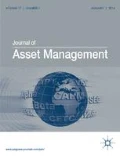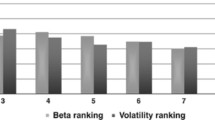Abstract
We compared performance of mean–variance portfolios (MVPs) based on Pearson’s correlations (PeMVPs) and partial correlations (PaMVPs) with equal-weight portfolios (EWPs) for several tradable US equity index ETFs. We found that performance of MVPs and EWPs depends on two factors: the constituents of the underlying equity index and its holding period. When a market-wide index contained super-high growth technology stocks, such as FAANNG in the SPDR S&P 500 ETF, PeMVP being a concentrated growth portfolio unsurprisingly outperformed more diversified PaMVP and EWP. However, when FAANNG were dropped from the SPDR S&P 500 ETF, and even in the case of the SPDR S&P 500 Growth ETF (that does not have relatively low-performing value stocks), PaMVP outperformed PeMVP at one-month holding period. For other US equity index SPDR ETFs (S&P 500 Value, S&P MidCap 400, and S&P 600 SmallCap), PaMVP was always superior, and EWP could outperform PeMVP at shorter holding periods.

Similar content being viewed by others
References
Aguet, D., N. Amenc, and F. Goltz. 2019. What Really Explains the Poor Performance of Factor Strategies over the Last 3 years? Scientific Beta, EDHEC Risk Institute.
Becker Y. L. and M. R. Reinganum. 2018. The Current State of Equity Investing. CFA Institute Research Foundation.
Booth, D., and E. Fama. 1992. Diversification returns and asset contributions. Financial Analysts Journal 48: 26–32. https://doi.org/10.2469/faj.v48.n3.26.
DeMiguel, V., L. Garlappi, and R. Uppal. 2009. Optimal versus naïve diversification: How inefficient is the 1/N portfolio strategy? Review of Financial Studies 22: 1915–1953.
DeMiguel, V., Y. Plyakha, R. Uppal, and G. Vilkov. 2013. Improving portfolio selection using option-implied volatility and skewness. Journal of Financial and Quantitative Analysis 48: 1813–1845.
Duchin, R., and H. Levy. 2009. Markowitz versus the Talmudic portfolio diversification strategies. Journal of Portfolio Management 35: 71–74.
Elton, E.J., M.J. Gruber, S.J. Brown, and W.N. Goetzmann. 2009. Modern Portfolio Theory and Investment Analysis. New York: Wiley.
Fama, E.F., and K. French. 1993. Common risk factors in stock and bond returns. Journal of Financial Economics 33: 3–56.
Gerber, S., H. Markowitz, and P. Pujara (2015). Enhancing Multi-Asset Portfolio Construction Under Modern Portfolio Theory with a Robust Co-Movement Measure. Available at SSRN: http://ssrn.com/abstract=2627803.
Green, R.C., and B. Hollifield. 1992. When will mean-variance efficient portfolios be well diversified? Journal of Finance 47: 1785–1809.
Hirschman, A.O. 1964. The paternity of an index. The American Economic Review 54(5): 761.
Jacobs, H., S. Müller, and M. Weber. 2013. How should individual investors diversify? An empirical evaluation of alternative asset allocation policies. Journal of Financial Markets 19: 62–85.
Jagannathan, R., and T. Ma. 2003. Risk reduction in large portfolios: Why imposing the wrong constraints helps. Journal of Finance 58: 1651–1684.
Johnston, J., and J. DiNardo. 1997. Econometric Methods. New York: McGraw-Hill.
Kenett, D.Y., M. Tumminello, A. Madi, G. Gur-Gershgoren, R.N. Mantegna, and E. Ben-Jacob. 2010. Dominating clasp of the financial sector revealed by partial correlation analysis of the stock market. PLoS ONE 5: e15032.
Kenett, D.Y., M. Raddant, L. Zatlavi, T. Lux, and E. Ben-Jacob. 2012. Correlations in the global financial village. International Journal of Modern Physics Conference 16: 13–28.
Kenett, D.Y., X. Huang, I. Vodenska, S. Havlin, and H.E. Stanley. 2015. Partial correlation analysis: Applications for financial markets. Quantitative Finance 15: 569–578.
Kritzman, M., S. Page, and D. Turkington. 2010. In defense of optimization: The fallacy of 1/N. Financial Analysts Journal 66: 31–39.
Lee, W. 2011. Risk-based asset allocation: A new answer to an old question? The Journal of Portfolio Management 37(4): 11–21.
Markowitz, H. 1952. Portfolio selection. The Journal of Finance 7: 77–91.
Nadler D. and A.B. Schmidt (2014). Portfolio Theory in Terms of Partial Covariance. Available at SSRN: http://ssrn.com/abstract=2436478.
Ross A, T.J. Moskowitz, R. Israel, and L. Serban. 2017. Implementing Momentum: What have We Learned? Available at SSRN: https://ssrn.com/abstract=3081165.
Schmidt, A.B. 2009. Simulation of maker loss in the global inter-bank FX market. Journal of Trading 3(4): 66–70.
Schmidt, A.B. 2018. Managing portfolio diversity within the mean variance theory. Annals of Operations Research. https://doi.org/10.1007/s10479-018-2896-x.
Shapira, Y., D.Y. Kenett, and E. Ben-Jacob. 2009. The index cohesive effect on stock market correlations. European Physics Journal B 72: 657–669.
Tu, J., and G. Zhou. 2009. Markowitz meets Talmud: A combination of sophisticated and naïve diversification strategies. Journal of Financial Economics 99: 204–215.
Whittaker, J. 1990. Graphical Models in Applied Multivariate Statistics. New York: Wiley.
Willenbrock, S. 2011. Diversification return, portfolio rebalancing, and the commodity return puzzle. Financial Analysts Journal 67(4): 42–49. https://doi.org/10.2469/faj.v67.n4.1.
Acknowledgements
We are grateful to anonymous reviewers for valuable comments.
Author information
Authors and Affiliations
Corresponding author
Additional information
Publisher's Note
Springer Nature remains neutral with regard to jurisdictional claims in published maps and institutional affiliations.
Rights and permissions
About this article
Cite this article
Cai, H., Schmidt, A.B. Comparing mean–variance portfolios and equal-weight portfolios for major US equity indexes. J Asset Manag 21, 326–332 (2020). https://doi.org/10.1057/s41260-020-00173-2
Revised:
Published:
Issue Date:
DOI: https://doi.org/10.1057/s41260-020-00173-2




